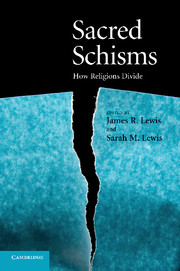Book contents
- Frontmatter
- Contents
- List of figures
- Notes on contributors
- Acknowledgments
- Introduction
- PART I THEORETICAL OVERVIEW
- PART II SURVEY OF SCHISMS IN SELECTED TRADITIONS
- 2 Charismatic authority in Islam: an analysis of the cause of schisms in the ummah
- 3 Schisms in Buddhism
- 4 Schisms in Japanese new religious movements
- PART III CHRISTIAN TRADITIONS
- PART IV WESTERN ESOTERIC TRADITIONS
- PART V NON-WESTERN/POSTCOLONIAL TRADITIONS
- Index
3 - Schisms in Buddhism
Published online by Cambridge University Press: 24 October 2009
- Frontmatter
- Contents
- List of figures
- Notes on contributors
- Acknowledgments
- Introduction
- PART I THEORETICAL OVERVIEW
- PART II SURVEY OF SCHISMS IN SELECTED TRADITIONS
- 2 Charismatic authority in Islam: an analysis of the cause of schisms in the ummah
- 3 Schisms in Buddhism
- 4 Schisms in Japanese new religious movements
- PART III CHRISTIAN TRADITIONS
- PART IV WESTERN ESOTERIC TRADITIONS
- PART V NON-WESTERN/POSTCOLONIAL TRADITIONS
- Index
Summary
While popular notions of Buddhism in the twentieth and twenty-first centuries have often assumed that Buddhism is, and was, as poised, polished, and monochromatic as those charming jade Buddha-statues found in Asian-American restaurants, a bit of familiarity with Buddhist history suggests otherwise. In fact, it would probably be no exaggeration to say that the history of Buddhism, in the twenty-five centuries since the Buddha's death, could be told as a series of schismatic developments. To make sense of this fractious history, this chapter will present a thumbnail account of the evolution of Buddhism in India, Tibet, and East Asia, along with some brief comments about Buddhism in the Occident. In offering this historical overview of Buddhist schisms, which will be by definition partial and minimalist, I have selected particular developments based on whether they either add something to our appreciation of the vicissitudes of the Buddhist tradition, or provide potentially useful information for comparative reflections.
In light of the material found in the Buddhist tradition, I believe we will do fine defining “schism” simply as “a publicly recognized division within a religious group.” As in any tradition, such a division could emerge from disagreements over doctrine, history, leadership, practices, or institutional arrangements. In defining “schism” in this broad manner, the point is not just that schisms result from differences of opinion over an issue, but also that these differences have been elevated into “identity-producing” divides.
- Type
- Chapter
- Information
- Sacred SchismsHow Religions Divide, pp. 61 - 82Publisher: Cambridge University PressPrint publication year: 2009
- 1
- Cited by



